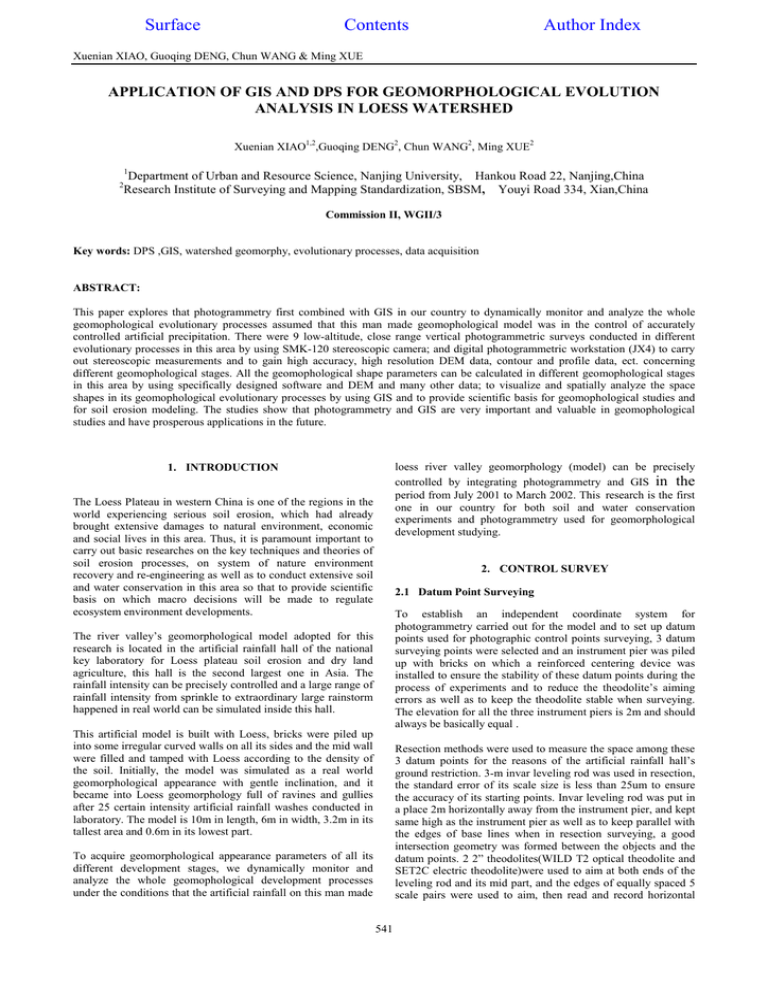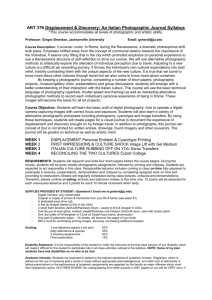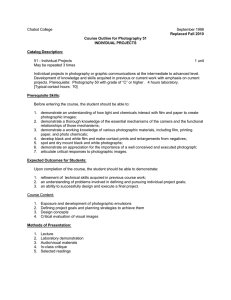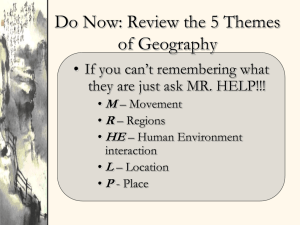APPLICATION OF GIS AND DPS FOR GEOMORPHOLOGICAL EVOLUTION
advertisement

Surface Contents Author Index Xuenian XIAO, Guoqing DENG, Chun WANG & Ming XUE APPLICATION OF GIS AND DPS FOR GEOMORPHOLOGICAL EVOLUTION ANALYSIS IN LOESS WATERSHED Xuenian XIAO1,2,Guoqing DENG2, Chun WANG2, Ming XUE2 1 Department of Urban and Resource Science, Nanjing University, Hankou Road 22, Nanjing,China Research Institute of Surveying and Mapping Standardization, SBSM, Youyi Road 334, Xian,China 2 Commission II, WGII/3 Key words: DPS ,GIS, watershed geomorphy, evolutionary processes, data acquisition ABSTRACT: This paper explores that photogrammetry first combined with GIS in our country to dynamically monitor and analyze the whole geomophological evolutionary processes assumed that this man made geomophological model was in the control of accurately controlled artificial precipitation. There were 9 low-altitude, close range vertical photogrammetric surveys conducted in different evolutionary processes in this area by using SMK-120 stereoscopic camera; and digital photogrammetric workstation (JX4) to carry out stereoscopic measurements and to gain high accuracy, high resolution DEM data, contour and profile data, ect. concerning different geomophological stages. All the geomophological shape parameters can be calculated in different geomophological stages in this area by using specifically designed software and DEM and many other data; to visualize and spatially analyze the space shapes in its geomophological evolutionary processes by using GIS and to provide scientific basis for geomophological studies and for soil erosion modeling. The studies show that photogrammetry and GIS are very important and valuable in geomophological studies and have prosperous applications in the future. loess river valley geomorphology (model) can be precisely controlled by integrating photogrammetry and GIS in the period from July 2001 to March 2002. This research is the first one in our country for both soil and water conservation experiments and photogrammetry used for geomorphological development studying. 1. INTRODUCTION The Loess Plateau in western China is one of the regions in the world experiencing serious soil erosion, which had already brought extensive damages to natural environment, economic and social lives in this area. Thus, it is paramount important to carry out basic researches on the key techniques and theories of soil erosion processes, on system of nature environment recovery and re-engineering as well as to conduct extensive soil and water conservation in this area so that to provide scientific basis on which macro decisions will be made to regulate ecosystem environment developments. 2. CONTROL SURVEY 2.1 Datum Point Surveying To establish an independent coordinate system for photogrammetry carried out for the model and to set up datum points used for photographic control points surveying, 3 datum surveying points were selected and an instrument pier was piled up with bricks on which a reinforced centering device was installed to ensure the stability of these datum points during the process of experiments and to reduce the theodolite’s aiming errors as well as to keep the theodolite stable when surveying. The elevation for all the three instrument piers is 2m and should always be basically equal . The river valley’s geomorphological model adopted for this research is located in the artificial rainfall hall of the national key laboratory for Loess plateau soil erosion and dry land agriculture, this hall is the second largest one in Asia. The rainfall intensity can be precisely controlled and a large range of rainfall intensity from sprinkle to extraordinary large rainstorm happened in real world can be simulated inside this hall. This artificial model is built with Loess, bricks were piled up into some irregular curved walls on all its sides and the mid wall were filled and tamped with Loess according to the density of the soil. Initially, the model was simulated as a real world geomorphological appearance with gentle inclination, and it became into Loess geomorphology full of ravines and gullies after 25 certain intensity artificial rainfall washes conducted in laboratory. The model is 10m in length, 6m in width, 3.2m in its tallest area and 0.6m in its lowest part. Resection methods were used to measure the space among these 3 datum points for the reasons of the artificial rainfall hall’s ground restriction. 3-m invar leveling rod was used in resection, the standard error of its scale size is less than 25um to ensure the accuracy of its starting points. Invar leveling rod was put in a place 2m horizontally away from the instrument pier, and kept same high as the instrument pier as well as to keep parallel with the edges of base lines when in resection surveying, a good intersection geometry was formed between the objects and the datum points. 2 2” theodolites(WILD T2 optical theodolite and SET2C electric theodolite)were used to aim at both ends of the leveling rod and its mid part, and the edges of equally spaced 5 scale pairs were used to aim, then read and record horizontal To acquire geomorphological appearance parameters of all its different development stages, we dynamically monitor and analyze the whole geomophological development processes under the conditions that the artificial rainfall on this man made 541 IAPRS, VOLUME XXXIV, PART2, COKKISSION II, Xi’an, Aug. 20-23, 2002 angles. The distance values between two points (base line) were determined on the basis of surveying records, their distance standard error respectively to be: m1=±0.3mm; m2=±0.25mm. 4. STEREO IMAGE PAIRS MEASUREMENT Helava total digital photographic workstation was used for digitizing images on this model, including polyester photograph scanning and digital image processing, etc. Photoshop 6.0 was used to process images. 2.2 Photographic Control Points Surveying Considering the real situation of this model, totally 18 photographic control points were selected to ensure the model’s surveying accuracy and to ensure at least 4 photographic control points to be kept for each image pair. Among the 18 photographic control points, 16 were set up on the model’s edges every 2m away from each other, and 6 points were set up inside the model (all on the ridges of the gullies in this model). These 18 photographic control points should be set up as much as possible be equally spaced and should form some equilateral triangulations. Some black and white metal materials alternately marking the photographic marks were arranged for each photographic control point. As for the model’s relative position and absolute position determining as well as data collecting, the image matching functions of JX4 total digital photographic workstation was used. These include contour and characteristic topographic points and lines’ stereoscopic surveying, the number of characteristic lines should be increased as much as possible during data collection so that to fully display this model. The collection area should be extended beyond about 10cm when collect contours. It is difficult to automatically produce DEM, because the texture and colors of the images inside this river valley model are very close. The above data by JX4 total digital photographic workstation software were used to formally shape it as an irregular triangulation network and then interpolated it into DEM. grid unit is 1mm, average standard error for elevation is ±1.85mm.Maped graphic editing system was used to edit vector graphics. Forward intersection methods were used to measure the horizontal coordinates of the photographic control points, direction observation techniques were used to observe horizontal angles, and WILD T2 optical theodolite and SET2C electrical theodolite were used for observation. The tip of the 0.5mm needle was used as aiming marks to precisely aim at the middle of the to be photographed object.Then we got the horizontal coordinates of the photographic control points, the standard error of those points are ±0.288mm. Leveling survey was used to measure the elevation of each lphotographic control point, the required instruments are Ni002 automatic level and 2m invar leveling rod to meet the accuracy requirement of national first order leveling. The rod was installed on a 3mm diameter steel ball to ensure that the bottom of this rod can properly contact with the sides of the marks, the variation of the diameter of this steel ball is less than 0.02mm. 5. GEOMORPHOLOGICAL PARAMETERS COMPUTATION Following are the geomorphological parameters computing steps: a) Data preprocessing: including DEM edge cutting, sorting out all the lines representing main stream and its branches as well as sketching out all the bottom lines of the branch gullies; b) DEM interpolating computation; c) Computation of volume, surface area and projected area: including the main stream ,its branches, the branch gullies and its parts; d) Computation of elevation of all the sampling points at the bottom of the branch gullies. 3. LOW ALTITUDE PHOTOGRAPHY SMK-120 precise stereoscopic camera was used for photography, single camera was used during photography for the reasons of the variation of photographic base lines. Photographic sensitive plate adopts hard infrared type to fit the e sensitivity nature of Loess image. The area’s following geomorphological appearance parameters of different development stages will be computed with specially developed software: general surface parameters in this area mainly include the area, length and width as well as the perimeter of this area; surface structure parameters in this area mainly are the elevation difference in this area and the number, length, depth and gradient of the main stream and its all branches in this area; surface variation parameters in this area mainly include this area’s volumes in different evolutionary stages, the volumes of the main stream and all its branches, as well as the volumes and areas of all the catchments of the main stream and its branches. Low altitude vertical photographic methods were used because of the experiment requirements and the experimental ground restriction. The camera was installed on a frame specially built with steel pipes for photographic use, box level was used to make the camera keep level; to effectively increase the photographic scale in the lower part of this model, the photographic frame should: the upper part of this model is 9m, 2 image pairs should be done and their photographic base lines respectively are 1.5m and 1.5m, the square distance of the photographed objects (flight height) are respectively: 5.95m, 6.25m, 6.98m; the lower part is 7.5m, 2 image pairs were done and their photographic base lines respectively are 1.2m and 1.4m, the square distance of the photographed objects (flight height) are respectively: 5.78m, 6.18m and 6.62m. GIS(Arcview)can be used to visualize the spatial appearances of this area’s geomorphological development processes. From the Figure1 to Figure4 shows the images of DEM and contour,which belong to different stages of the area’s geomorphological development processes(early,middle and last); ARCINFO was used to do DEM computation and spatial analysis in different period of time for the purpose to make the soil movement within this area much more clearer. (showed as Figure5,green area indicate soil which be piled up in the bottom of the gullies ). White powder was sprayed at the bottom of each gullies and on the topographic varying locations to enhance the contrast of Loess images, and to improve the stereoscopic effects from stereo images as well as to make the gullies and ravines much more clearer on the model. 542 Xuenian XIAO, Guoqing DENG, Chun WANG & Ming XUE Figure 1. Image of 2th DEM Figure 4. Image of contour Figure 2. Image of 5th DEM Figure 5. Image got by 4th DEM –5th DEM 6. CONCLUSION Photogrammetry and GIS integration will provide scientific data for analyzing and studying the geomorphological develoment processes and for soil erosion modeling in this area. It can’t only compute and display the spatial variations of all the geographic units in this model, but the idea of space surveying and spatial analysis also can provide broad basis for us to carry out soil erosion principle studying, ecosystem recovery and re-engineering as well as regional extensive soil and water conservation in Loess Plateau, and this idea will have important scientific means for macro decisions making regulating ecosystem environmental developments. The results show that GIS and photographmmetry have important scientific means for geomorphological development processes studying in this area and will get broad applications in the future. Figure 3. Image of 9th DEM ACKNOWLEDGEMENTS The authors gratefully acknowledge support from the national key laboratory for loess plateau soil erosion and dry land Lab. We would also like to thank lingzhou Chui, hongxin Du and peizhou Zhao for their significant contribution to the research. 543 IAPRS, VOLUME XXXIV, PART2, COKKISSION II, Xi’an, Aug. 20-23, 2002 544





